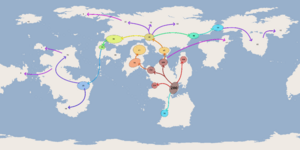Human history
Human history, or the history of the world, is the record of events in the past, informed by many disciplines of science and humans' own writing. Note that history on this page is preliminary, and subject to change.
Prehistory
Early humans

Homo sapiens are considered to have differentiated from other related chimpanzees and bonobos around 300 thousand years ago, with the earliest evidence found in central Yazland. Modern behavior likely evolved around 50,000 years ago. Humans quickly spread over the lower sea levels into southern Ashnan and Etzavaz, with migrations to the southern half of Yazland coming much later. Expansion into Huo and Jarruunh likely took place at the climax of the last ice age, when sea levels would have been at their lowest and island chains would lead seafaring peoples to the two continents.
The migration of anatomically modern humans out of Africa took place in multiple waves beginning 200,000–175,000 years ago. H. sapiens proceeded to colonize all the continents and larger islands, arriving in Nkungu 35,000 years ago, Huo 25,000 years ago and Jarruunh 8,000 years ago. By the end of the Ice Age some 12,000 years ago, humans had colonized nearly all ice-free parts of the globe. H. sapiens expansion coincided with both the Quaternary extinction event and the extinction of all but one other human species. These extinctions were probably caused by climate change, human activity, or a combination of the two. Nevertheless, Hashkas remained uncontacted by humans on Anschuhe until a few thousand years ago.
Early civilizations
Beginning around 8,000 BCY, evidence of early civilization first appears in northern Yazland and southern Ashnan, with the domestication of various crops such as wheat, sorghum, and amaranth, and the domestication of livestock such as goats and pigs. Agriculture began independently in different parts of the globe, and included a diverse range of taxa, in at least X separate centers of origin. Crop cultivation and animal domestication had occurred in the Ziwagh River Valley by at least 4000 BCY in the form of brachiaria, sorghum, urochloa, cattle and water buffaloes. The Dayeu River Valley in East Ashnan domesticated rice around 3500 BCY; the Cicex River Valley may have cultivated millet by 3000 BCY.
Early proto-cities appeared at X and Y, possibly as early as the 6th or 5th millenia BCY. Pastoral societies based on nomadic animal herding also developed, mostly in dry areas unsuited for plant cultivation such as the Ashnan Steppe as well as Central and Eastern Nkungu. Even at this early stage of civilization, we can still see early signs of conflict between societies as well as religious beliefs. Metalworking was first used in the creation of copper tools and ornaments around 2000 BCY. Gold and silver soon followed, primarily for use in ornaments. The first signs of bronze date to around 500 BCY, but the alloy did not become widely used until the second century BCY.
Ancient history (100 CY to ??? CY)
Early Bronze Age
The Bronze Age, taking its name from the discovery of metallurgy and bronze tools, saw the rise of the first city-states and the invention of writing. These settlements were concentrated in Huo and around the Triangle Sea.
Hundred-year drought and Bronze Age collapse
everyone died and went to hell
Post-classical history (mid-3000s CY to early 4000s CY)
The Prophet fucked and killed his wife
Modern history
idk the copper war and stuff